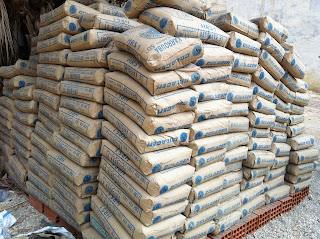Types of Portland Cement
• Different types of Portland cement are manufactured to meet the requirements for specific purposes• The American Society for Testing and Materials (ASTM) Designation C150 specifies the following eight types of Portland cement
| Type | |
| Type I | Normal |
| Type IA | Normal, air entraining |
| Type II | Moderate sulfate resistance |
| Type IIA | Moderate sulfate resistance, air entraining |
| Type III | High early strength |
| Type IIIA | High early strength, air entraining |
| Type IV | Low heat of hydration |
| Type V | High sulfate resistance |
Type I cement
• It is a general-purpose cement used in concrete for making pavements, floors, reinforced concrete buildings, bridges, tanks, pipes, etc.• It is used in concrete not subjected to aggressive exposures, such as sulfate attack from soil and water, or to an objectionable temperature rise
Type II cement
• It is used where precaution against moderate sulfate attack is important, as in drainage structures, which may be subjected to a moderate sulfate concentration from ground waters•It usually generates less heat of hydration at a slower rate than Type I cement and therefore can be used in mass structures such as large piers, heavy abutments, and retaining walls
• Due to less heat generation it can be preferred in hot weather
Type III cement
• It is chemically and physically similar to Type I cement, except that its particles have been ground finer• It provides high early strengths at an early period, usually a week or less
• It is used when forms need to be removed as soon as possible or when the structure must be put into service quickly
• It is preferred in cold weather for reduction in the curing period
Type IV cement
• It is used where the rate and amount of heat generated from hydration must be minimized• It develops strength at a slower rate than other cement types
• It is most suitably used in massive concrete structures, such as large gravity dams, where the temperature rise resulting from heat generated during hardening must be minimized to control the concrete cracking
Type V cement
• It is used only in concrete exposed to severe sulfate action – principally where soils or ground waters have a high sulfate content• Its high sulfate resistance is due to its low C3A content of about 4%
• It is not resistant to acids and other highly corrosive substances
Air-Entraining Portland Cements
(Types IA, IIA, and IIIA)
• These cements have same composition as Types I, II, and III, respectively, except that small quantities of air-entraining material are inter-ground with the clinker during manufacture• These cements produce concrete with improved resistance to freeze-thaw action and to scaling caused by chemicals applied for snow and ice removal.
White Portland Cement
• It has composition same as Type I or Type III cement, except that it has a white color instead of gray color• It is made of selected raw materials containing negligible amounts of iron and magnesium oxides-the substances that give cement its gray colors
• It is used primarily for architectural purposes
Blended Hydraulic Cements
• These cements are produced by intimately and uniformly blending the Portland cement and the by-product materials, such as blast-furnace slag, fly ash, silica fume and other pozzolanas• ASTM C 596 recognizes five classes of blended cements:
o Portland blast-furnace slag cement-Type ISo Portland pozzolana cement-
Type IP and Type P
o Pozzolana-modified Portland cement-Type I(PM)o Slag cement-Type S
o Slag-modified Portland cement.
Type I(SM)
Masonry Cements
• These cements are used in mortar for masonry construction• ASTM C 91 classifies masonry cements as: Type N, Type S, and Type M
Expansive Cements
• These cements are primarily used in concrete for shrinkage control• ASTM C 845 classifies masonry cements as:Type E-1(K), Type E-1(M), Type E-1(S)
Special Cements (Not covered by ASTM)
| Type | Uses |
| 1. Oil-well cements | For sealing oil wells |
| 2.Waterproof Portland cements | For reducing capillary water transmission |
| 3. Plastic cements | For making plaster and stucco |
Chemical Compounds in Portland Cement
As indicated earlier the burning operation of the raw materials results into the reaction between the oxides and four compound compositions are formed in the final cement product, as follows:C3S = 3CaO.SiO2 (Tricalcium silicate)
C2S = 2CaO.SiO2 (Dicalcium silicate)
C3A = 3CaO.Al2O3 (Tricalcium aluminate)
C4AF = 4CaO. Al2O3.Fe2O3 (Tetracalcium aluminoferrite)
Role of Compound Composition
1. C3S• Hydrates and hardens rapidly and is largely responsible for initial set and early strength
• Early strength of cement is higher with increased percentages of C3S
2. C2S
• Hydrates and hardens slowly
• Contributes largely to strength increase at ages beyond one week
3. C3A
• Liberates a large amount of heat during the first few days of hydration and hardening
• Also contributes slightly to early strength development
• Gypsum added to the cement slows down the hydration rate of C3A
• Cements with low percentages of C3A are especially resistant to soils and waters containing sulfates
4. C4AF
• Does not play any significant role in hydration.

